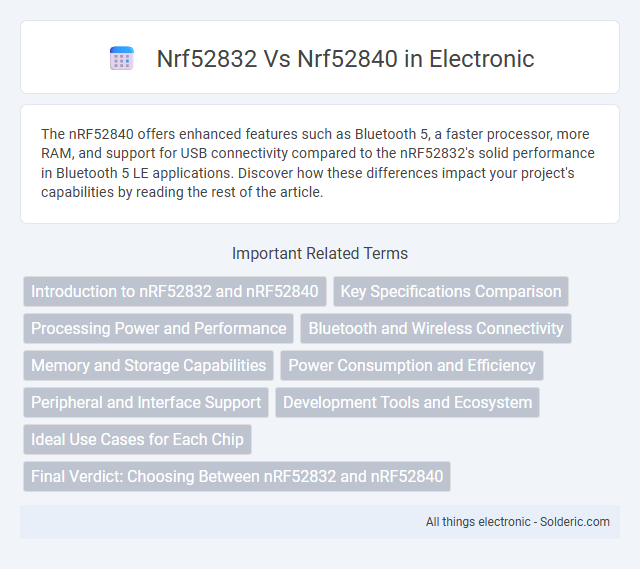The nRF52840 offers enhanced features such as Bluetooth 5, a faster processor, more RAM, and support for USB connectivity compared to the nRF52832's solid performance in Bluetooth 5 LE applications. Discover how these differences impact your project's capabilities by reading the rest of the article.
Comparison Table
| Feature | nRF52832 | nRF52840 |
|---|---|---|
| Processor | ARM Cortex-M4, 64 MHz | ARM Cortex-M4F, 64 MHz |
| Flash Memory | 512 KB | 1 MB |
| RAM | 64 KB | 256 KB |
| Bluetooth Version | Bluetooth 5, Bluetooth Low Energy | Bluetooth 5, Bluetooth Low Energy, Bluetooth Mesh, Thread, Zigbee |
| USB Support | No | Yes, USB 2.0 Full Speed |
| Radio | 2.4 GHz, 1 Mbps, 2 Mbps, 125 kbps (coded PHY) | 2.4 GHz, 1 Mbps, 2 Mbps, 125 kbps (coded PHY), Long Range |
| Maximum Output Power | +4 dBm | +8 dBm |
| Cryptography | AES-ECB, CCM, GCM | AES-ECB, CCM, GCM, RSA, ECC |
| Connectivity | BLE, ANT | BLE, ANT, Thread, Zigbee |
| Package Types | QFN48 | QFN73, QFN63 |
Introduction to nRF52832 and nRF52840
The nRF52832 and nRF52840 are popular Bluetooth Low Energy (BLE) System on Chips (SoCs) from Nordic Semiconductor, designed for wireless communication and IoT applications. The nRF52832 features a 64 MHz ARM Cortex-M4 processor with 512 KB flash and 64 KB RAM, offering efficient performance for low power devices. In contrast, the nRF52840 provides enhanced capabilities with a 64 MHz ARM Cortex-M4 processor, 1 MB flash, 256 KB RAM, and support for Bluetooth 5, Thread, Zigbee, and USB, making it suitable for more complex and versatile wireless projects.
Key Specifications Comparison
The nRF52840 offers a more powerful Cortex-M4F processor running at 64 MHz compared to the nRF52832's 64 MHz Cortex-M4, but the nRF52840 includes more RAM (256 KB vs. 64 KB) and Flash memory (1 MB vs. 512 KB). Both support Bluetooth 5, but the nRF52840 also supports Bluetooth 5.2, Thread, and Zigbee, providing greater wireless versatility. Your choice depends on whether you prioritize enhanced memory and protocol support with the nRF52840 or a more cost-effective solution with the nRF52832.
Processing Power and Performance
The nRF52840 features a 64 MHz ARM Cortex-M4F processor with floating-point unit, offering superior processing power compared to the nRF52832's 64 MHz Cortex-M4 without an FPU, enhancing computational efficiency in complex applications. With 1 MB flash and 256 KB RAM, the nRF52840 supports more extensive code and data handling than the nRF52832's 512 KB flash and 64 KB RAM, boosting performance for memory-intensive tasks. This processing advantage enables the nRF52840 to excel in advanced IoT applications requiring high throughput and real-time data processing.
Bluetooth and Wireless Connectivity
The nRF52840 supports Bluetooth 5.2 with higher data throughput, enhanced range, and improved coexistence features compared to the nRF52832, which implements Bluetooth 5.0. Both chips offer multiprotocol wireless connectivity, but the nRF52840 adds support for 802.15.4, enabling Thread and Zigbee protocols for versatile IoT applications. Your choice will impact device performance and compatibility in Bluetooth and wireless network environments.
Memory and Storage Capabilities
The nRF52840 offers 1MB Flash memory and 256KB RAM, providing significantly higher storage capacity compared to the nRF52832's 512KB Flash and 64KB RAM. This expanded memory on the nRF52840 enables handling more complex applications, larger firmware, and advanced Bluetooth LE features. Your choice between these SoCs should consider these memory differences to ensure optimal performance for your project's requirements.
Power Consumption and Efficiency
The nRF52832 offers lower power consumption during active and sleep modes, making it ideal for battery-operated devices requiring maximum efficiency. The nRF52840 supports higher performance tasks with increased power usage but incorporates advanced power management features to optimize energy use in complex applications. Your choice depends on whether you prioritize minimal power draw or enhanced functionality for your IoT projects.
Peripheral and Interface Support
The nRF52840 offers enhanced peripheral and interface support compared to the nRF52832, including USB 2.0 full-speed capability, an additional UART interface, and support for NFC-A tag operations. Both chips provide SPI, I2C, PWM, and ADC, but the nRF52840 supports more GPIO pins and higher RAM capacity, allowing for more complex peripheral integration. These features make the nRF52840 better suited for advanced IoT applications requiring diverse connectivity and sensor interfaces.
Development Tools and Ecosystem
The nRF52840 offers a more comprehensive development ecosystem with support for advanced tools like Segger Embedded Studio, Keil, and GCC, alongside Nordic's SDK and Zephyr OS, catering to robust application development. The nRF52832 is well-supported but generally targets simpler projects with fewer peripheral options and less extensive throughput capabilities in its SDK. Your choice between the two influences access to software libraries, middleware support, and community resources that can accelerate development and enhance product capabilities.
Ideal Use Cases for Each Chip
The nRF52832 is ideal for compact Bluetooth Low Energy (BLE) devices such as wearables, fitness trackers, and simple IoT sensors due to its efficient power consumption and smaller memory footprint. The nRF52840 supports more advanced applications requiring higher processing power, increased memory, and multi-protocol connectivity, making it suitable for complex IoT devices, smart home hubs, and industrial automation systems. Both chips excel in BLE communication, but the nRF52840's USB support and enhanced features make it the preferred choice for advanced wireless applications.
Final Verdict: Choosing Between nRF52832 and nRF52840
The nRF52840 offers superior performance with a 64 MHz ARM Cortex-M4 processor, more memory (1 MB flash, 256 KB RAM), and enhanced Bluetooth 5 features compared to the nRF52832's 64 MHz Cortex-M4 with 512 KB flash and 64 KB RAM. Your choice depends on application complexity and future-proofing needs, where the nRF52840 supports advanced protocols, USB connectivity, and higher data throughput. For basic Bluetooth LE projects, the nRF52832 is cost-effective and efficient, while the nRF52840 excels in demanding, feature-rich applications requiring extensive wireless capabilities.
nrf52832 vs nrf52840 Infographic

 solderic.com
solderic.com